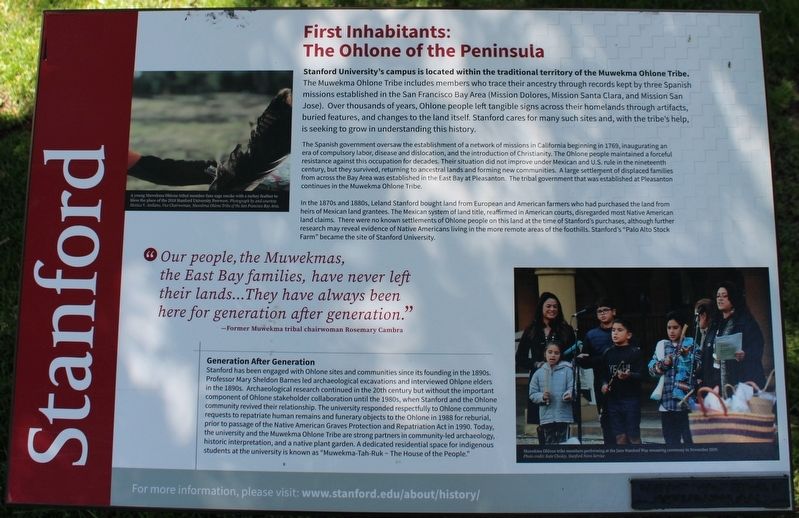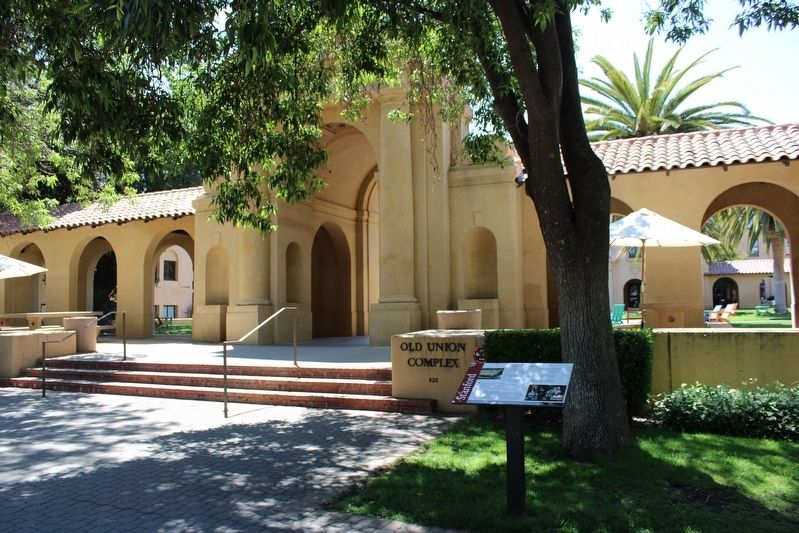Stanford in Santa Clara County, California — The American West (Pacific Coastal)
First Inhabitants: The Ohlone of the Peninsula
The Spanish government oversaw the establishment of a network of missions in California beginning in 1769, inaugurating an era of compulsory labor, disease and dislocation, and the introduction of Christianity. The Ohlone people maintained a forceful resistance against this occupation for decades. Their situation did not improve under Mexican and U.S. rule in the nineteenth century, but they survived, returning to ancestral lands and forming new communities. A large settlement of displaced families from across the Bay Area was established in the East Bay at Pleasanton. The tribal government that was established at Pleasanton continues in the Muwekma Ohlone Tribe.
,br> In the 1870s and 1880s, Leland Stanford bought land from European and American farmers who had purchased the land from heirs of Mexican land grantees. The Mexican system of land title, reaffirmed in American courts, disregarded most Native American land claims. There were no known settlements of Ohlone people on this land at the time of Stanford's purchases, although further research may reveal evidence of Native Americans living in the more remote areas of the foothills. Stanford's "Palo Alto Stock Farm" became the site of Stanford University.
”Our people, the Muwekmas, the East Bay families, have never left their lands... They have always been here for generation after generation."
-Former Muwekma tribal chairwoman Rosemary Cambra
Generation After Generation
Stanford has been engaged with Ohlone sites and communities since its founding in the 1890s. Professor Mary Sheldon Barnes led archaeological excavations and interviewed Ohlone elders in the 1890s. Archaeological research continued in the 20th century but without the important component of Ohlone stakeholder collaboration until the 1980s, when Stanford and the Ohlone community revived their relationship. The university responded respectfully to Ohlone community requests to repatriate human remains and funerary objects to the Ohlone in 1988 for reburial, prior to passage of the Native American Graves Protection and Repatriation Act in
1990. Today, the university and the Muwekma Ohlone Tribe are strong partners in community-led archaeology, historic interpretation, and a native plant garden. A dedicated residential space for indigenous students at the university is known as "Muwekma-Tah-Ruk~ The House of the People."
For more information, please visit: www.stanford.edu/about/history/
Erected by Stanford University.
Topics. This historical marker is listed in these topic lists: Education • Exploration • Native Americans • Settlements & Settlers. A significant historical year for this entry is 1769.
Location. 37° 25.503′ N, 122° 10.174′ W. Marker is in Stanford, California, in Santa Clara County. Marker can be reached from Lasuen Mall south of Panama Mall, on the right when traveling south. The resin marker is mounted to a metal post in front of the Old Union Complex. Touch for map. Marker is at or near this postal address: 450 Jane Stanford Way, Stanford CA 94305, United States of America. Touch for directions.
Other nearby markers. At least 8 other markers are within walking distance of this marker. Generations of Diverse Perspectives (a few steps from this marker); The Stanford Women’s Clubhouse (within shouting distance of this marker); Welcome to the Stanford Clock Tower (about 400 feet away, measured in a direct line); Restoration of the Stanford Campus (approx. 0.2 miles away); Motion Picture Research Commemoration (approx. 0.2 miles away); The Burghers of Calais (approx. 0.2 miles away); Exploring the Forces of Nature (approx. 0.2 miles away); Nourishing the Whole Student (approx. ¼ mile away). Touch for a list and map of all markers in Stanford.
More about this marker. Inset Images:
A young Muwekma Ohlone tribal member fans sage smoke with a turkey feather to bless the place of the 2018 Stanford University Powwow. Photograph by and courtesy Monica V. Arellano, Vice Chairwoman, Muwekma Ohlone Tribe of the San Francisco Bay Area.
Muwekma Ohlone tribe members performing at the Jane Stanford Way renaming ceremony in November 2019. Photo credit: Kate Chesley, Stanford News Service
Also see . . . A history of Stanford.
"When Jane Lathrop Stanford and railroad magnate and former California Gov. Leland Stanford lost their only child, Leland, Jr., to typhoid in 1884, they decided to build a university as the most fitting memorial, and deeded to it a large fortune that included the 8,180-acre Palo Alto stock farm that became the campus. They made their plans just as the modern research university was taking form."(Submitted on September 3, 2023, by Joseph Alvarado of Livermore, California.)
Credits. This page was last revised on September 3, 2023. It was originally submitted on September 3, 2023, by Joseph Alvarado of Livermore, California. This page has been viewed 85 times since then and 14 times this year. Photos: 1, 2. submitted on September 3, 2023, by Joseph Alvarado of Livermore, California.

